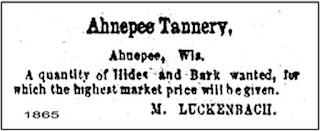 |
| Bearcat's No More- February 2022 |
When Andy LaFond left Algoma a dozen or so years ago, a long
history of commercial fishing went with him. The fire at Bearcat’s during the
summer of 2021, and the subsequent decision to close the store, was the demise
of another long history. The fire at Bearcat’s was not the location’s first. In
1883, there was another conflagration, one that affected local business.
The fish in the river and in the lake were a food source for
the first three settling families who arrived in the wildness – today’s Algoma - in the week ending on July 4, 1851,
just as the fish were for the Potawatomi people along the lakeshore for eons. Almost 170 years later, those who were not fisherfolk themselves knew where
to get fresh fish. And that was in town.
Bearcat’s was a destination, and its closing affects the
local economy. Its location is historic. Dating nearly to first settlement, the
location had an economic prominence, which waxed and waned in all that time,
but economic nonetheless.
A potash ash maker by trade, Jonathon Newman opened his potashery on the site that became Bearcat’s, the northwest corner of 4th and Navarino in the Fiebrantz Plat, which appears to be Algoma’s smallest plat extending, from 4th Street to the east side of 6th Street, from the north side of Navarino to the river.
Newman’s potashery business and Hall’s lumber mills were the first industrial ventures in Wolf River, Algoma’s first name. Newman opened his potash factory in the late 1850s, however business was not very successful. By 1865, Michael Luckenbach had purchased the property, converting it to a tannery, although the potashery kettles remained for years and figured into the play of area kids.
The Record informed readership that Van Meverdan was turning out fine leather goods in addition to selling plastering hair, but then Van Meverdan's business caught fire in July 1883. Luckily, the firemen were able to extinguish the fire before the business was a total loss. Although the fire's origins were not clear, it was felt that coal and ashes falling into the liquid mixing vat was the cause. Insurance covered damages estimated to fall between $200 and $300, which translates to 7,000 to 8,000 dollars in 2022.
Meverden continued tannery operations until he closed and sold the property in April 1889. During the same year, city voters passed a bond issue in favor of relocating the Kelsey Fly Net Co.to the site. Prior to its relocation, George Kelsey, Sr. briefly operated on the second floor of the panel factory and in Marr’s Lace factory. Once again, the tannery was outfitted with new machinery, but this time for making flynets, which were made by fastening cords on a loom and tying the cords to make a net. The nets had dangling strings and when put on a horse, the nets shake and drive flies away.
 |
| Flynets |
It was in 1939
that Cities Service distributor Henry G. Muench announced the construction of a
gas station on the corner. It was operated by Leon Kashik. A year later, George
Brey took over. Brey had the business until about 1965 when Ralph Scherer
rented and operated the station until 1974. In 1987 Chuck and Cindy Bohman
opened Toot’s Fish and Galley, which offered retail sales of fish, fish plates,
sandwiches, and deli items. Norman and Rita Paul bought the property in 1990 when
Mrs. Paul had an H & R Block office. Since Linda and Jerry Berkovitz purchased
the property in 1996, Bearcat’s Fish Shop has been a fixture on the corner
until the fire. Bill and Nicole Smith bought the shop in 2012 and owned it at
the time of the fire.
For the first
time in almost 170 years, one can no longer purchase fresh fish in Algoma. But
one can no longer purchase potash, have leather tanned in town, or purchase
Cities Service gas either. However, in the event you are building and want to
do your own plastering, John Van Meverdan left his 1888 recipe for enough
plaster to cover 100 sq. yards of wall: 8 bushels of lime, 16 bushels of
sand, and 1 bushel of horsehair, but it might be hard to find that much
horsehair!

No comments:
Post a Comment